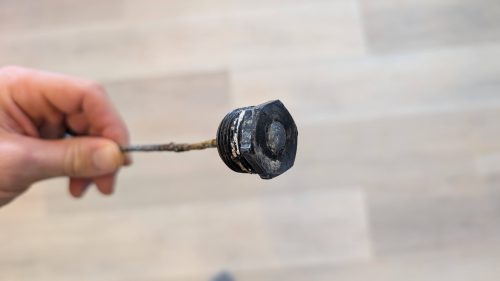Water heater manufacturers tell you to remove and inspect the anode rod yearly, but seriously, who does this? Nobody! An anode rod is big stick of aluminum, magnesium, or zinc that comes with your water heater. It’s there to prevent the tank from corroding away. The less noble metal corrodes, thereby saving your tank. Once the rod has completely corroded away, all you’re left with is a piece of wire, and the water heater tank will likely fail soon afterward.
Why nobody inspects their anode rode
I tried to inspect my anode rod once. There’s a 1-1/16″ nut at the top of the water heater, which is connected to the anode rod. Just remove this nut and the anode rod comes out.
I’m using the word “just” liberally.
I put a socket wrench on the nut but couldn’t get it to budge. So I put a pipe on the end of my socket wrench to give me more leverage. I cranked on it, and my entire water heater began to turn, putting a ton of stress on the water lines and the gas line.
I also tried using an impact driver; I have a Milwaukee M18 Fuel 1/4″ hex impact driver, and it was useless. At that point, I gave up on the project. I didn’t want to purchase an impact wrench just to satisfy my curiosity, and I didn’t think it was all that important.
Curiosity got the best of me
After discovering the anode rod on my little point-of-use water heater was completely gone in a year, I got concerned about my whole-house water heater. I know from experience that water heaters in my city, Maple Grove, last about seven years. It’s a water chemistry thing. I figured it has to be related to the anode rod corroding away, so I decided to get whatever tool is needed to access my anode rod on my four-year-old water heater.
I asked my plumber friend Tim at Paul Bunyan Plumbing about this on a recent podcast about water heater maintenance, and he told me they use an impact wrench. So I bought one, even though I hate buying new toys… er, I mean tools ;-). I picked up the Milwaukee M18 1/2″ Mid-torque Impact Wrench, which easily loosened the anode rod. You can see it in the video clip above.
I wasn’t entirely surprised to find my anode rod completely gone. All that remained was the wire stick in the middle.
Powered Anode Rod
Because I was prepared to find this, I had already ordered a new anode rod. My plumber friend Tim recommended a powered anode rod, which uses black magic and electricity to prevent the tank from corroding. So I bought a Corro-Protec® anode rod for $159.95 on Amazon, and it was a piece of cake to install.
I could have purchased another magnesium rod, but knowing my anode rod might only last a year or two here in Maple Grove, I think I might save money this way.
Installing this thing was a piece of cake. I applied some Teflon tape to the threads, screwed it into place on my water heater, and connected the power supply. It took about five minutes after I had removed my old anode rod.
Conclusion
Replacing a worn or depleted anode rod will increase the life of your water heater. Mine was completely gone within four years… but that’s all I know. Maybe it was gone after only a year or two. Now I’ll be on a crusade to check several more of them.
The next time I help a friend or neighbor replace a water heater, I might suggest installing a powered anode rod from day one. Why wait? I don’t have any proof these things work… but I’ll certainly circle back on this topic periodically to report on the condition of my water heater.
p.s. – days later, I helped my dad check the anode rod on his 9-year-old water heater in Saint Louis Park. There was absolutely nothing left; not even the wire rod.




Scott Zeiger
December 14, 2024, 1:49 pm
I’m a skeptic. How do we know in fact that it’s doing what it’s saying it’s supposed to do? Do they have side by side tests of their product in a tank and a sacrificial anode rod and another tank and let them sit for 4 years do you know?
Reuben Saltzman
December 16, 2024, 5:32 pm
Hi Scott,
Yeah, I’m a bit skeptical myself. I have no proof this will work. Give me a decade and I’ll get back to you 😉
Chris H
February 15, 2025, 2:12 pm
Thanks Reuben – after waffling about doing this on-&-off for years, I just installed a Corro-Protec on our ~9-month old water heater. Its anode rod was already impressively pitted when I removed it. The recommendation to use an impact wrench was clutch — that made it super easy. Thank you for this post and the nudge to finally get me to do this project!
Reuben Saltzman
February 17, 2025, 2:22 pm
Hey Chris, that’s great to hear! I hope the electric anode rod is all it’s cracked up to be.